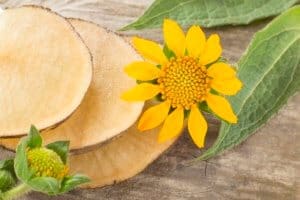Smallanthus sonchifolius is an order of plants found in both South and North America. Probably the most famous of the smallanthus species is commonly called Yacon. Yacon is a distant relative of the sunflower with edible tubers and leaves.
History & Traditional Usage of Yacon
Yacon has its roots in the Andes. It is believed that it originated from the high Andean Region now known as eastern Bolivia and southern Peru. Legend has it that Inca messengers would dig up the succulent tubers from beside the trail to slake their thirst. Yacon is currently grown from Ecuador to Argentina and Brazil as a staple food crop by many indigenous peoples, some of which have used the plant ceremonially as well. Yacon is related to sunflowers with large succulent tuber roots that have a juicy, watermelon flavor.
Benefits & Uses
 Fresh Yacon tubers are crisp and juicy with a delicate flavor reminiscent of apple or melon and a surprising sweetness that increases in storage. They can be eaten raw, (fresh or dried) steamed, baked, roasted, or juiced. The somewhat bitter skin can be scrubbed off with a stiff brush, peeled with a vegetable peeler, or removed after baking. One of our favorite recipes is to simply chop the peeled tubers into bite-size pieces and sauté them in a little butter until the sugar begins to caramelize. Serve with mashed potatoes topped with fresh parsley.
Fresh Yacon tubers are crisp and juicy with a delicate flavor reminiscent of apple or melon and a surprising sweetness that increases in storage. They can be eaten raw, (fresh or dried) steamed, baked, roasted, or juiced. The somewhat bitter skin can be scrubbed off with a stiff brush, peeled with a vegetable peeler, or removed after baking. One of our favorite recipes is to simply chop the peeled tubers into bite-size pieces and sauté them in a little butter until the sugar begins to caramelize. Serve with mashed potatoes topped with fresh parsley.
While satisfyingly sweet and flavorful, it remains low in calories. This is due to the fact that the sugar contains high levels of oligofructose (inulin), a form of sugar that is not metabolized readily by the human body.
Yacon contains fructooligosaccharides (FOS), which pass through the digestive track unmetabolized, providing few calories. The sugars, however, are metabolized by the bifidobacteria in the large intestine and contribute to improved digestions and absorption of vitamins, such as B-complex. The undigested portion of the tuber serves as prebiotic-food for “friendly” bacteria.
Yacon is considered by many to be a superfood of the future.
